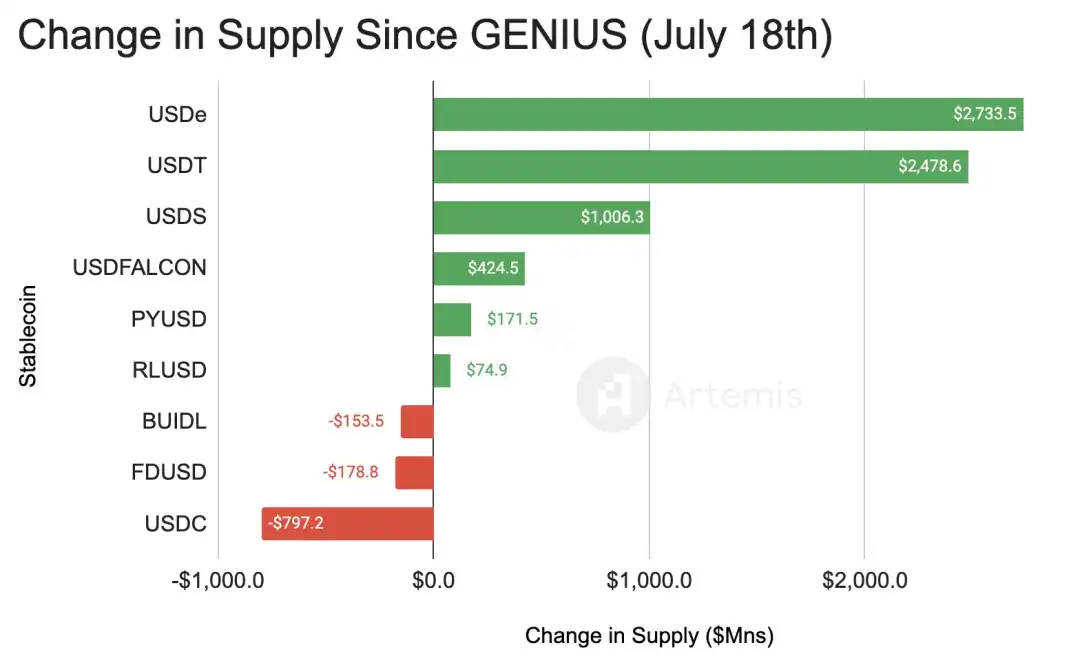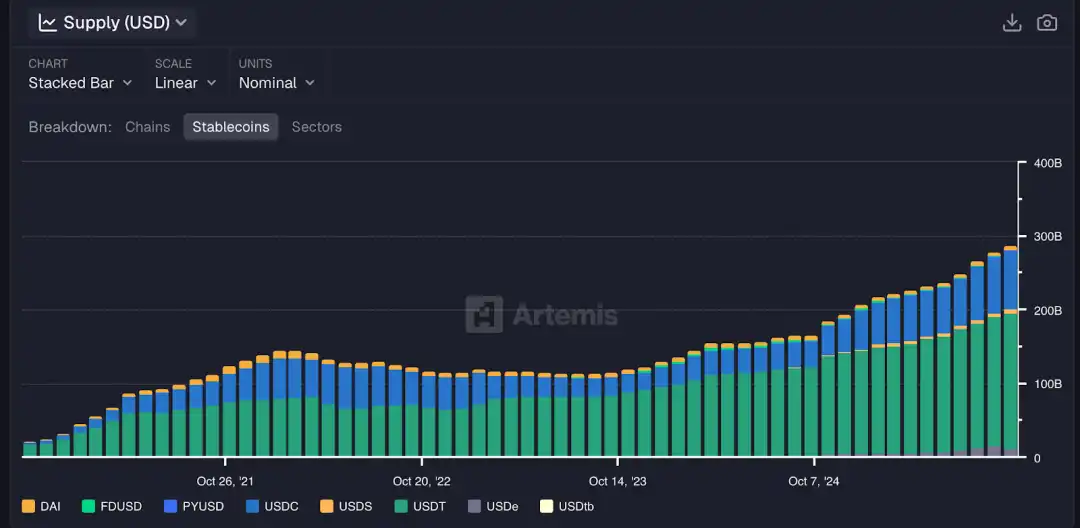A New $300 Billion Blue Ocean: Three Main Lines of the Stablecoin Ecosystem
Investing in the new stablecoin sector requires finding a balance among technological innovation, regulatory compliance, and market demand.
Original Title: "A New $300 Billion Blue Ocean: Three Main Lines of the Stablecoin Ecosystem"
Original Author: Louis, Biteye
Introduction: A Historical Turning Point for the Stablecoin Ecosystem
From 2024 to 2025, the global stablecoin market is experiencing unprecedented explosive growth. As of October, the total market capitalization of stablecoins has surpassed $300 billion, up from $166.3 billion at the end of 2024, representing an annual growth rate of 82.9%. This growth not only sets a new historical record but also marks a fundamental shift for stablecoins from marginal speculative tools to mainstream financial infrastructure.

Current Market Stablecoin Total Supply and Trading Volume Data
Historic breakthroughs in the regulatory environment have provided strong momentum for this growth: In July 2025, the U.S. GENIUS Act was officially signed into law, establishing the first federal-level stablecoin payment framework. Meanwhile, the EU's MiCA regulation came into full effect in December 2024, laying a solid foundation for the standardized development of the stablecoin industry.

Stablecoin Growth After the GENIUS Act
Although USDT and USDC still dominate, their market share has dropped from 91.6% to 83.6%. The stablecoin market is quietly changing, with emerging stablecoin projects rising rapidly, such as:
· Ethena's USDe market cap has reached $11 billion
· PayPal's PYUSD market cap has surpassed $2.76 billion
· RWA-backed stablecoin market size has reached $35 billion, with an annual growth of 46%

Market Share of Various Stablecoins
Stablecoin-Dedicated Public Chains: Infrastructure Revolution
Traditional blockchains have exposed significant pain points in processing stablecoin transactions: Ethereum's high gas fees often reach tens of dollars, and transaction confirmation times range from seconds to minutes; while Tron has lower fees, it faces centralization risks and technical limitations.
The new generation of dedicated stablecoin public chains has achieved qualitative breakthroughs through technological innovation. These public chains generally support high throughput of 1000+ TPS, zero or ultra-low fees, and sub-second transaction confirmation. More importantly, they design stablecoins as native gas tokens, completely eliminating the impact of cryptocurrency price volatility on user experience.
Plasma: The Flagship Project of the Tether Ecosystem
As the leading project in the sector, Plasma has raised a total of $75.8 million, including a $20.5 million Series A round in February 2025 led by Bitfinex and Framework Ventures, with participation from notable investors such as Peter Thiel and Bybit. After the mainnet test launch on September 25, 2025, TVL quickly reached $5.3 billion.
On the technical side, Plasma adopts a customized PlasmaBFT consensus mechanism, achieving sub-second finality and processing capacity of over 2000 TPS. Its core innovation lies in the Paymaster system, enabling truly zero-fee USDT transfers, while supporting custom gas tokens and confidential payment features. The project has integrated Chainlink oracles and built a complete DeFi ecosystem by bridging non-custodial Bitcoin (pBTC).
Stable: Institutional-Grade USDT Optimization Solution
Stable positions itself as "real-world payment rails," focusing on institutional-grade USDT applications. In July 2025, the project secured $28 million in seed funding, jointly invested by Franklin Templeton, Hack VC, PayPal Ventures, and Bitfinex. The project uses StableBFT consensus, supports 10k TPS and second-level finality, while maintaining EVM compatibility.
Stable's technical features include using USDT as the native gas token and achieving zero-fee P2P transfers through account abstraction. Enterprise features include batch transfer aggregation, compliant private transfers, and cross-chain USDT0 support. The project has integrated PayPal's PYUSD stablecoin, focusing on fiat on/off ramps and debit card issuance.
Arc: Circle's Exclusive Ecosystem
Developed by Circle, Arc is positioned as "the home of stablecoin finance," deeply integrating the Circle ecosystem. The project uses USDC as the native gas token, ensuring a predictable USD-denominated fee structure. Technically, it adopts the Malachite BFT consensus engine, supporting 3000 TPS and sub-second finality.
Arc's uniqueness lies in its built-in FX engine, supporting quote-based stablecoin conversion and optional privacy features for compliant shielding. The project is also exploring reversible USDC transactions to address fraud issues and is working with Deutsche Börse to promote adoption in the EU market.
In terms of funding scale and technological progress, Plasma holds a leading advantage thanks to Tether ecosystem support and the earliest mainnet launch. Stable builds differentiated competitiveness through its institutional positioning and PayPal partnership, while Arc relies on Circle's compliance advantage and USDC ecosystem status. All three projects adopt BFT consensus mechanisms, which are more suitable for payment scenarios compared to the probabilistic finality of traditional PoS.
Yield-Bearing Stablecoins: Innovative Yield Models
Yield-bearing stablecoins embed returns directly into the stablecoin, providing users with a yield experience that surpasses traditional bank savings.
Ethena USDe
USDe's market cap soared from $86 million in January 2024 to $11.04 billion in October 2025, an astonishing increase of 13,750%, making it the world's third-largest stablecoin.
USDe's technical innovation lies in maintaining stability through a delta-neutral strategy, staking assets such as ETH and WBTC while opening hedged futures positions on exchanges, creating a non-directional risk exposure. sUSDe provides holders with an annualized yield of 2.56%-3.72%, with returns sourced from Ethereum staking rewards, perpetual contract funding rates, and stablecoin fixed income.
Sky Ecosystem
The Sky ecosystem (formerly MakerDAO) has reshaped the decentralized stablecoin lending market through brand upgrades and product innovation. USDS, as a reward-based stablecoin, has reached a market cap of $8 billion, offering users an annualized yield of 4.75% through the Sky Savings Rate mechanism.
Yields come from protocol surpluses, including lending fees and liquidation income, distributed to savings users via the SSR mechanism. The project has also launched the Endgame plan for SubDAO restructuring, providing different services through specialized sub-protocols such as Spark, Grove, and Keel.
Stablecoin Payment Infrastructure: Reshaping Global Finance
In 2025, stablecoin cross-border payment processing volume reached $46 trillion, equivalent to over 50% of Visa's throughput. Traditional cross-border payment fee structures typically range from 2-7%, including transfer fees, exchange rate spreads, and intermediary fees, while stablecoins can reduce costs to 0.5-2%, saving 50-80% in high-frequency cross-border scenarios. More importantly, stablecoin settlement times are reduced from the traditional 3-5 business days to under 3 minutes, greatly reducing pre-financing needs and cash flow interruptions.
BVNK's Strong Rise
As a stablecoin infrastructure provider, BVNK achieved strong business growth in 2025, processing over $20 billion in annual transaction volume, mainly serving enterprise clients such as Worldpay, Flywire, and dLocal. Citi Ventures made a strategic investment in BVNK in October 2025, supporting its global stablecoin payment rail expansion. At the same time, Coinbase and Mastercard are negotiating to acquire BVNK, with a valuation of $1.5-2.5 billion, which would be the largest stablecoin acquisition in history, highlighting its core position in enterprise-level stablecoin payments.
Stripe's Innovative Deployment
Stripe has launched a stablecoin subscription payment feature, supporting automatic USDC deductions on Base and Polygon chains, targeting the needs of AI and SaaS companies. This feature halves settlement costs, and AI companies report that 20% of payment volume has shifted to stablecoins. Stripe has also launched the Open Issuance platform to help enterprises issue custom stablecoins and integrated AI agent payment tools.
Stablecoin AI Integrated Applications: The Future of Finance
With the rise of the AI agent economy, traditional API keys and subscription models can no longer meet the needs of autonomous machine-to-machine transactions, giving rise to payment protocols and infrastructure optimized specifically for AI agents.
KITE AI: Building the Layer-1 for the Agent Internet
KITE AI, as a leading project in this field, is committed to building the first Layer-1 blockchain optimized for the AI agent economy. KITE completed an $18 million Series A round led by PayPal Ventures and General Catalyst.
The project's core innovation lies in three technological pillars: the encrypted agent identity system (AIR - Agent Identity Resolution), programmable permission management, and on-chain attribution intelligent proof (PoAI). AIR serves as an agent app store, solving trust issues between AI agents. Developers can deploy custom agents and access the ecosystem market through a low-code interface.
Recently, KITE and Brevis announced a strategic partnership, leveraging zero-knowledge proof technology to enhance the transparency and autonomy of agent identity and payment modules. The first batch of modules will be deployed on BNB Chain, with subsequent expansion to KITE L1 to achieve cross-chain proof relays.
x402 Protocol: Redefining the HTTP Payment Standard
The x402 protocol is jointly promoted by tech giants such as Coinbase, Google, and Cloudflare. When a client (such as an AI agent or application) accesses a protected resource, the server returns a 402 status code and payment details in JSON format, including amount, currency, and receiving address. The client then constructs a signed payment transaction and resends the request with the X-PAYMENT header. Third-party facilitators such as Coinbase verify the on-chain payment, after which the server grants resource access. The entire process achieves trustless execution, with payments settled on-chain to ensure auditability.
The technical advantage of x402 lies in its native HTTP integration and ultra-low transaction costs. USDC settlements on Base can be completed within 2 seconds, with gas fees below $0.0001 and zero protocol fees.
Investment Outlook and Risk Assessment
The stablecoin sub-sector is moving from concept to reality, from speculation to application. Among the four emerging tracks, dedicated stablecoin public chains show the clearest investment value. Plasma, backed by the Tether ecosystem and validated by $5.3 billion in TVL, has a clear technological moat. As enterprise-level payment demand explodes, such infrastructure projects are expected to command premium valuations. Enterprise-level payment solutions benefit from improved regulatory environments, and BVNK's $1.5-2.5 billion acquisition valuation reflects traditional financial giants' recognition of stablecoin infrastructure. AI integrated applications are still in the early stages, but the speed of technological innovation and scenario validation has exceeded expectations, making them suitable for investors with higher risk appetites. Yield-bearing stablecoins have the most complex risk-reward ratio, and the de-pegging risk of synthetic models under extreme market conditions cannot be ignored.
Regulatory risk remains the biggest variable. Although the GENIUS Act and MiCA regulations provide a framework for industry development, specific implementation rules and enforcement standards are still evolving. Stablecoin projects need to continuously monitor compliance costs and policy changes. Competition risk is intensifying as traditional financial giants enter the space. The strategic deployments of companies such as Stripe, Visa, and Mastercard will reshape the market landscape, and emerging projects need to maintain a leading edge in technological innovation and ecosystem building.
Investing in the new stablecoin sector requires finding a balance among technological innovation, regulatory compliance, and market demand. With key projects launching in 2025 and regulatory frameworks becoming clearer, this round of stablecoin infrastructure upgrades is expected to reshape the global payment landscape and bring substantial returns to early participants.
Disclaimer: The content of this article solely reflects the author's opinion and does not represent the platform in any capacity. This article is not intended to serve as a reference for making investment decisions.
You may also like
YouBallin: Reshaping the Reputation System of Decentralized Creator Platforms
The decentralized creator economy platform YouBallin has officially launched globally. The platform is built on the high-performance blockchain Solana, ...

Discussion on MSTR's Q3 2025 Financial Report
MSTR can purchase up to $42.1 billion worth of Bitcoin.

Fed turns hawkish? Barclays: Powell aims to "break the expectation of inevitable rate cuts," and data supports more rate cuts
Barclays believes that the market's hawkish interpretation of Powell's remarks is a misjudgment.

NEO ignites the robotics sector—what Robotic projects are worth paying attention to?
An overview of projects related to the Robotics sector.

